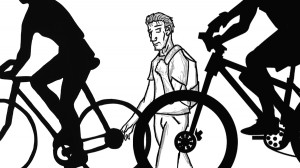Bike lanes are a positive step forward
The installation of bike lanes along Trousdale Parkway is the university’s clever answer to USC’s ever-present bike safety problem. Installed at an optimal time — the beginning of a new school year — this is a solid first step toward a tangible solution to the hazards caused by the way students get around campus.
Over the last few decades, as USC has transitioned from being a commuter campus to a more residential campus, students have turned to bikes as their choice of transportation. But the University Park Campus’ varied pathway sizes prove it was not designed to handle a lot of bike traffic.
Several proposed solutions to the problem of having too many bikes on campus are very unappealing — particularly those that would ban bike riding on campus — and reaching a compromise could allow pedestrians and cyclists to coexist on thoroughfares safely.
The current bike lanes, which could be effective in containing bike traffic and separating students from walking on the same path, already seem to have one problem. Though the university publicized the new bikes lanes thoroughly with emails and ads in the Daily Trojan, some parts of the lanes aren’t as clearly marked, as the medians are moveable and short. It’s easy for a pedestrian to accidentally wander into the area, even when Dept. of Public Safety officers are directing students to walk in the appropriate areas. It’s hard to tell right now if that will be a persistent problem or if longer barriers should be erected.
Otherwise, the lanes seem to work. As a former bicyclist on campus and a current walker, it’s easy to see that the lanes are wide enough for a cyclist to ride along Trousdale while keeping distracted drivers from mowing me over. Lanes similar to this one could be instituted in other areas of campus, possibly on streets like McClintock Avenue and other larger walkways, including Childs Way. Adding infrastructure that flexibly directs bike traffic can steadily alter the way cyclists and the general traffic flow move on campus.
With admitted exceptions, some Trojans are responsible bikers who follow the state’s laws for biking on public roads. Unfortunately, campus is a different place where students continuously break the law out of ignorance or disregard. Adding more structure to roads on campus will hopefully make bikers more aware of the rules they have to follow.
What else can the university do to get students to follow these rules, both on and off campus? This could include a well-designed regurgitation of L.A. and California biking laws presented to freshmen or students registering their bikes with DPS. Though it’s ultimately not the university’s responsibility to make sure students know how to ride a bike without breaking the law, it could help resolve a persistent problem on our campus.
This certainly isn’t a final solution to the bike problem, but it’s a good way to get the ball rolling. Main thoroughfares during rush hours are chaotic enough when massive quantities of pedestrians squeeze through areas in different directions, especially when those walking who aren’t in a hurry awkwardly block traffic to chat. Adding bikes to the mix has made congestion along USC’s busier walkways and intersections straight-up dangerous.
The Trousdale bike lane is the first physical change to campus to come from the “We are Considerate. We are USC.” campaign, and it’s a solid start to alleviating USC’s bike hazard problem.
Rachel Bracker is a junior majoring in linguistics. Point/Counterpoint runs Fridays.

